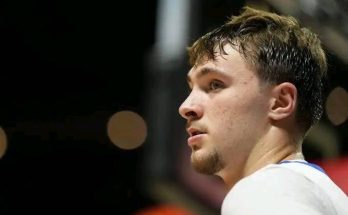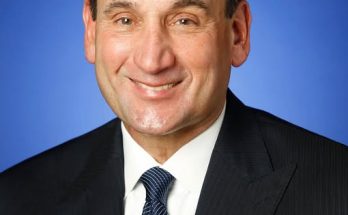Koby Brea’s name echoed through the Barclays Center in Brooklyn on June 26, 2025, as he was selected 41st overall in the NBA Draft—a pick originally belonging to the Golden State Warriors that was swiftly traded to the Phoenix Suns. From the moment his name was called, it was clear that his selection was more than a draft-day transaction; it was a tribute to resilience, dedication, and the transformative journey of a sharpshooter who defied expectations and rewrote his own narrative.
Born on November 6, 2002, in The Bronx to Dominican parents, Brea’s basketball journey began with modest recognition. He attended Norman Thomas High School in Manhattan as a freshman, only to be cut from the team. Undeterred, he transferred to Monsignor Scanlan in the Bronx, suiting up for junior varsity before earning a varsity role in his junior year. By his senior campaign he was a captain, averaging 20.8 points and 7.8 rebounds per game, and earning second-team All-New York honors—his rising performance marking a trajectory others didn’t initially foresee .
Brea’s collegiate career began at the University of Dayton, where he embraced the role of a sixth man. He claimed the Atlantic 10 Sixth Man of the Year twice, in 2022 and again in 2024, solidifying his position as a national leader in three-point shooting by the end of his tenure there, sinking an astounding 49.8% from beyond the arc—NCAA-best for six seasons . However, his path was halted in 2023 by stress fractures in both tibias. Surgery was required, and he spent an arduous summer in a wheelchair
The comeback that followed was the hallmark of Brea’s character. He returned to the court for the 2023–24 season with a laser-like focus, averaging 11.1 points and reclaiming the national lead shooting 49.8% from three. That resilience and performance earned him a graduate transfer to the University of Kentucky, where he elevated his play in his lone season as a Wildcat, averaging 11.6 points, hitting 43.5% from deep, making 93 three-pointers (7th-most in school history), and often carrying the offensive load heavy minutes).
One of his defining career moments came at Rupp Arena against eventual national champion Florida, when Brea scored 23 points and drained seven threes—breaking free and electrifying the crowd as the Wildcats emerged victorious ([ukathletics.com][2]). He repeated that magic in the NCAA Tournament, delivering a clutch 23-point effort against Illinois to send Kentucky to the Sweet Sixteen . These performances cemented his profile as an elite catch-and-shoot assassin—and rightfully so, as noted by analysts and draft scouts .
Despite his proficiency as a scorer and shooter, Brea entered the draft with questions around his playmaking, defensive ability, and athleticism. Analysts flagged that while he excelled beyond the arc, he lacked creation off the dribble, averaged a modest 1.3 assists per game, and as an older prospect (22), garnered less upside than younger peers ([profootballnetwork.com][4]). At the NBA Combine, it was noted that his wingspan measured just over 6’5″—shorter than ideal for his 6’7″ frame—raising concerns about defending on the perimeter .
Nonetheless, the Phoenix Suns saw in him exactly what they needed: elite spacing, reliable perimeter shooting, and size that fits the modern NBA. Outside the top 30 picks, Brea represented a low-risk, high-reward addition. The Suns, coming off a season of changes including a Kevin Durant trade and coaching overhaul, were building around Devin Booker with a vision that emphasized floor spacing to unleash Booker’s offensive creativity. Acquiring Brea—alongside big additions like Rasheer Fleming and Mark Williams—signaled a strategic pivot toward balanced versatility ([valleyofthesuns.com][5]). As one site observed, the Suns “grabbed draft’s best specialist with a brilliant second‑round steal” ([valleyofthesuns.com][5]).
Kentucky head coach Mark Pope was effusive in his praise. Sharing a heartfelt message moments after the selection, Pope celebrated Brea’s resilience and defied odds: “Two years ago, Koby had a really tough surgery and spent an entire summer in a wheelchair. To see him come back from that, become a Kentucky legend and now make his way to the NBA has been incredible to witness” ([si.com][6]). For Pope, Brea became the first Kentucky player drafted under his lead, joining Amari Williams—picked later by Boston—in a transformative June evening .
A touching moment from the draft broadcast encapsulated the joy of Brea’s journey. He celebrated alongside his parents and younger brother; cameras caught the little one dazzling with jaw-dropping dribbling moves, even stealing a sliver of the spotlight—which prompted Brea’s playful, proud remark: “He’s looking flyer than me” ([timesofindia.indiatimes.com][8]). That glimpse into family pride echoed something deeper: that this moment was bigger than him—it honored the sacrifices and support that shaped his path.
Off the court, Brea’s achievement resonates deeply. As a Dominican-American from the Bronx, he joins an emerging lineage of Dominican talents in the NBA—displaying both cultural pride and representation. After joining national youth teams, he said that being able to “lift the Dominican flag” meant it wasn’t just for him—it was for his family and entire nation. He cited Al Horford and Karl-Anthony Towns—two established Dominican NBA veterans—as role models and aimed to emulate their longevity in the league .
Entering a Suns organization with a storied history of elite guards and a city hungry for championship contention, Brea’s arrival comes at an exciting juncture. Devin Booker remains the cornerstone, but to maximize his talent, Phoenix needs complementary shooters. Brea’s elite percentages (43.5% from three, 91.4% from the free-throw line) demonstrate his reliability, while his catch-and-shoot mechanics and familiarity running off screens align perfectly with offensive spacing schemes .
Yet, the leap to the NBA demands more than stroke—it demands versatility. Brea has expressed awareness of this, telling ClutchPoints, “I feel like I’m the best shooter in the Draft… but I also know there’s more parts of my game that scouts and coaches have been noticing … once I get my foot in the door, I’m able to keep becoming an even better shooter, but also keep growing different parts of your game.” He pledged to develop defense, ball-handling, and decision-making. Scouts confirm that teams in his draft process were impressed by his high basketball IQ and steady improvement from one season to the next .
Looking forward, the Suns are setting a stage ripe for Brea’s style. With perimeter shooters in demand, he could find playing time as a bench spark or even as a rotation regular, if he can prove enough defensively. Phoenix’s new management, led by General Manager Brian Gregory—a former Dayton coach—will likely value his proven shooting and character alignment . His draft slot—41st overall—positions him as a developmental gem with upside, the kind of player who can thrive in a system built for spacing and shooting.
At 22, he brings maturity and a backstory that speaks volumes. He entered college as a role player, endured serious injuries, and fought back elevating his game into the national spotlight. Each step—Dayton to Kentucky, junior to legend—was fueled by relentless work and belief. Kentucky’s coach, Mark Pope, described his rise as “incredible to witness”. Even now, as the lights of the NBA floor come on, Brea stands ready with humility, confidence, and professional hunger, stating on ESPN right after being chosen: “I’m an extreme competitor… I just want to be there and become the best version of myself and do whatever is asked of me. They’re going to get somebody that is all hands in”.
This moment marks the realization of a life’s ambition. He grew up a Bronx kid, became a Dominican-American success story, rose from being cut in high school to walking into the NBA’s draft. Now, chosen by the Phoenix Suns, he represents more than a pick—he signifies belief, resistance, and possibility. Behind the 41st pick lies a story of defying the odds, of a player armed with elite shooting and steely resolve. If he continues this journey the way he has led it, Koby Brea may well leave the Valley of the Sun illuminated by the fire of a sharpshooting champion.


